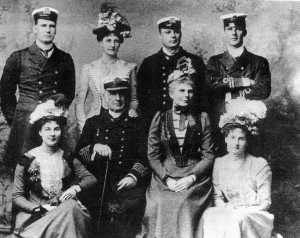- Author
- Haken, J.K., Dr
- Subjects
- Biographies and personal histories, Naval history, History - pre-Federation
- Tags
-
- RAN Ships
- None noted.
- Publication
- September 2006 edition of the Naval Historical Review (all rights reserved)
Francis Hixson served for fifteen years in the Royal Navy, rising to ship’s Captain and taking part in many surveys in the Pacific. He resigned to become Superintendent of Pilots, Lighthouses and Harbours in New South Wales, a position later redesignated as President of the Marine Board, and one he held until retirement. During the existence of the NSW Naval Brigade and later of the NSW Naval Forces, he was Captain Commanding.
Francis Hixson was born on 8 January, 1833, the son of a Master Mariner and his wife Anne (nee Manwell) at Swanage, Dorset, England. He followed his father’s connection with the sea, joining the Royal Navy as a Boy.
Service at Sea
In January 1848, as Master’s Assistant in HMS Savannah, he embarked on the first of a number of survey voyages. Parts of the Australian and New Zealand coast and the South Seas were surveyed before the ship returned to England in December 1851, where she was paid off.
He joined HMS Herald in February 1852, and took part in an expedition to survey and take possession of New Caledonia. On arrival, it was found that the French were already in residence, so surveying was carried out in the Fijian Islands and along part of the Australian coast. Hixson was promoted to Acting Second Master of Herald in 1855.
In February of that year, he was in command of a small armed party from HMS Torch which captured the murderers of a Mr. Strange and his companions on No 2 Percy Island.
On 4 June 1858, he jumped overboard and rescued Able Seaman Thomas Ross, then supported him in shark-infested water until a boat arrived. For his bravery, he was awarded the Silver Medal of the Royal Humane Society.
After nine years’ service, Herald returned to England, and under a joint agreement with the Colonial Government Hixson was appointed as Chief Assistant to Commander Sidney, RN, in the survey of the New South Wales coast. The cruise ended in Sydney in May 1860, and in September, he was awarded his Master’s Certificate. In 1861, he rejoined Herald and returned to England. He was appointed as Master of HMS Pelorus in 1862 and took part in further surveys of the NSW coast.
Positions held in NSW
On 1 January 1863 he resigned from the Royal Navy to accept the post of Superintendent of Pilots, Lighthouses and Harbours in New South Wales, a post later, on 2 April 1872, redesignated as President of the Marine Board, a position he held until his retirement in 1900. On 11 May 1863, the Colonial Government formed the NSW Naval Brigade with Hixson as Captain Commanding. Later, with the formation of the Naval Artillery Volunteers, he was appointed on 3 October 1888 as Captain Commanding the New South Wales Naval Forces, a post he held until his retirement on 30 June 1902. He was awarded the Volunteer Officers’ Decoration.
Captain Hixson was one of three founding Vice Presidents of the Royal United Service Institute of New South Wales which was founded in 1888.

One son, serving with the Queensland Naval Contingent, is not present.
In 1900, he commanded a detachment of the NSW Naval Brigade to Hong Kong where he handed over command to a Royal Navy officer, Lieutenant A Gillespie, RN, of HMS Mildura, who was appointed with the rank of Captain to the New South Wales Forces. Captain Hixson was accompanied by a son, Lieutenant H.O. Hixson, as Staff Officer on service in China. Another son, Lieutenant C. Hixson, served in the Contingent while a third son had volunteered for service.
The Naval Brigade under Hixson maintained reasonable numbers but was ineffective as a Naval Force, because the Government did not supply proper ships for training. For some years, a paid-off warship, HMCS Wolverine, which had been donated to the colony, was used for training. This vessel was of little use because its boilers were not suitable for prolonged sea use. Despite the limited value of the Naval Brigade, Captain Hixson was held in high esteem by the Maritime and general community.
Held in High Regard
Before a trip to England in February 1886 with Mrs. Hixson, officers of his Board presented him with an address and a pianoforte for Mrs. Hixson. The Steamship Owners’ Association of the Port presented him with an illuminated address and a purse of 120 sovereigns. A Naval parade of 500 also presented him with an address and Mrs. Hixson with a bracelet. As the steamer left the wharf, the steamers of Port Jackson with the Government Engineer, the Harbour Master, the Assistant Harbour Masters, the officers of the Harbours and Rivers Department, the Admiral with the Naval Brigade, with its band and citizens onboard, followed the steamer out of the harbour. The Government launch Nea and private launches followed the procession. Going past the harbour gates, the Naval Brigade in their launch drew alongside the steamer, which slowed. Flags were dipped and the band played ‘Auld Lang Syne’ and ‘Home Sweet Home’. The final parting took place off Macquarie Light just outside the heads.




